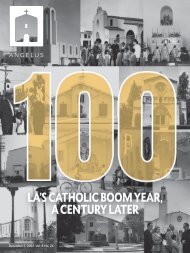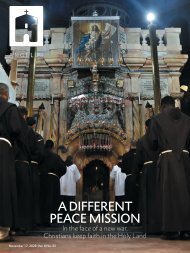Angelus News | March 22, 2024 | Vol. 9 No. 6
On the cover: To cap off a nearly five-decades-long career working in Church communications, Francis X. Maier had an ambitious book idea: a ‘snapshot’ of the Church in America at this time in history that captured both its strengths and its sicknesses. On Page 10, Maier shares what he took away from hearing more than 100 “confessions”’ with American Catholic leaders for the project. On Page 20, John L. Allen Jr. offers his own diagnosis of the uneasy relationship between U.S. Catholics and Rome during the Pope Francis pontificate.
On the cover: To cap off a nearly five-decades-long career working in Church communications, Francis X. Maier had an ambitious book idea: a ‘snapshot’ of the Church in America at this time in history that captured both its strengths and its sicknesses. On Page 10, Maier shares what he took away from hearing more than 100 “confessions”’ with American Catholic leaders for the project. On Page 20, John L. Allen Jr. offers his own diagnosis of the uneasy relationship between U.S. Catholics and Rome during the Pope Francis pontificate.
You also want an ePaper? Increase the reach of your titles
YUMPU automatically turns print PDFs into web optimized ePapers that Google loves.
closely with those of the “BRICS<br />
nations” (Brazil, Russia, India, China,<br />
and South Africa among them, as the<br />
acronym suggests) than they do with<br />
the White House, even under a liberal<br />
administration led by a Catholic and<br />
self-professed Francis admirer.<br />
Ad intra, with regard to the internal<br />
life of the Church, Francis is pursuing<br />
a program of “synodality,” a difficult<br />
term to define with precision but<br />
which, in broad strokes refers to a more<br />
participatory and inclusive ecclesial<br />
approach, rooted in compassion and<br />
dialogue, and with less emphasis on<br />
some of the traditional moral battles<br />
which have defined Catholic identity<br />
in America in recent decades, especially<br />
with regard to “life issues” such as<br />
abortion.<br />
Both of those transitions have been<br />
trying for some sectors of American<br />
Catholic opinion. To some extent, the<br />
tensions overlap with the usual left/<br />
right divides, though not exclusively so.<br />
Many American liberals, for instance,<br />
may find Francis’ refusal to forthrightly<br />
condemn Vladimir Putin, for example,<br />
even more frustrating than conservatives,<br />
some of whom feel a certain<br />
grudging admiration for the Russian<br />
leader.<br />
Standing back from the particulars<br />
of any given issue, what seems clear<br />
about American reaction to Francis<br />
that it cannot properly be understood<br />
in isolation, but rather as part of a more<br />
epochal shift in Catholicism — to wit,<br />
the rise of a global Church, one in<br />
which the United States simply is not<br />
the pivot point.<br />
A bit of math makes the point: There<br />
are 1.3 billion Roman Catholics in the<br />
world today and just over 60 million in<br />
the United States, which means that<br />
Americans account for slightly under<br />
5% of the global Catholic population.<br />
Put another way, 95% of the Catholics<br />
on the planet today are not Americans,<br />
and do not necessarily see the world<br />
through the lens of American experiences,<br />
interests, and priorities.<br />
Two-thirds of the world’s Catholics<br />
today live outside the boundaries of the<br />
West, in Africa, Asia, Latin America,<br />
the Middle East, Eastern Europe, and<br />
points beyond. By 2050, that non-Western<br />
share will be three-quarters.<br />
In such a far-flung global community<br />
of faith, Catholics in the U.S. increasingly<br />
will be pressured to make their<br />
peace with the reality that the Church,<br />
and its leadership, will not always react<br />
from within American categories or<br />
according to American logic. Right<br />
now, the tensions unleashed by this<br />
transition are focused on Francis, but<br />
they just as easily could be aroused by<br />
a pontiff from Congo, or Sri Lanka, or<br />
Myanmar — all, by the way, at least<br />
remotely plausible candidate nations to<br />
give the Church its next leader.<br />
To be clear, American Catholicism<br />
is hardly sliding toward irrelevance in<br />
global Catholic affairs. The Church in<br />
the U.S. wields mammoth resources,<br />
both human and financial, including<br />
by far the world’s leading network of<br />
Catholic institutions. They include<br />
schools and universities, hospitals<br />
and clinics, social service centers and<br />
humanitarian organizations, and on<br />
and on.<br />
Nevertheless, American Catholics<br />
need to be clear that the turbulence<br />
of the Francis era is not a one-off affair<br />
triggered by the idiosyncrasies of a gaucho,<br />
or cowboy, pontiff. It is, instead,<br />
a harbinger of things to come — perhaps<br />
not always in service to the same<br />
agenda, but unlikely to be predictably<br />
“American” in tone or content either.<br />
To put the point differently, the<br />
Francis papacy will pass, as all papacies<br />
eventually do. Yet the new and more<br />
complicated era in the global Church<br />
he embodies, with both its promise and<br />
its frustrations for Americans, appears<br />
here to stay.<br />
John L. Allen Jr. is the editor of Crux.<br />
Pilgrims take part in the annual Cirio de Nazaré procession in Belem, Brazil, Oct. 9, 20<strong>22</strong>. More than a million pilgrims<br />
take part in the procession, which takes place on the second Sunday of October and honors Our Lady of Nazareth. |<br />
CNS/RAIMUNDO PACCO, REUTERS<br />
<strong>March</strong> <strong>22</strong>, <strong>2024</strong> • ANGELUS • 21

















